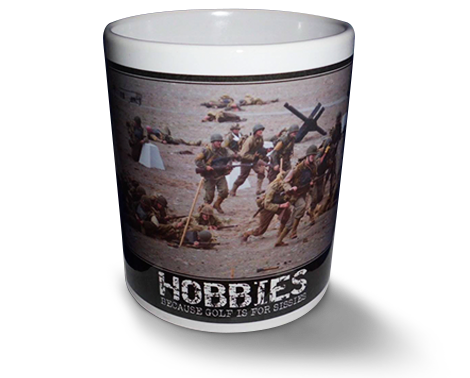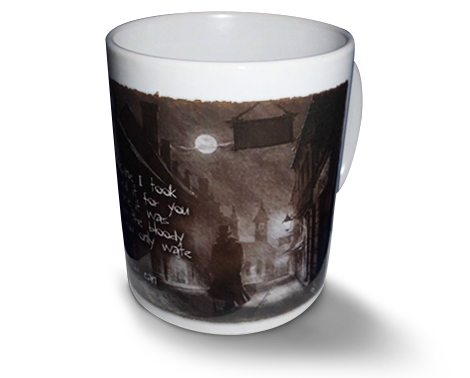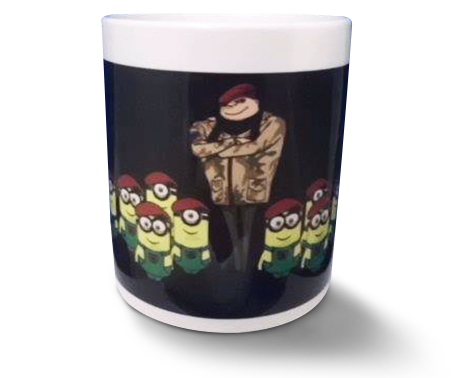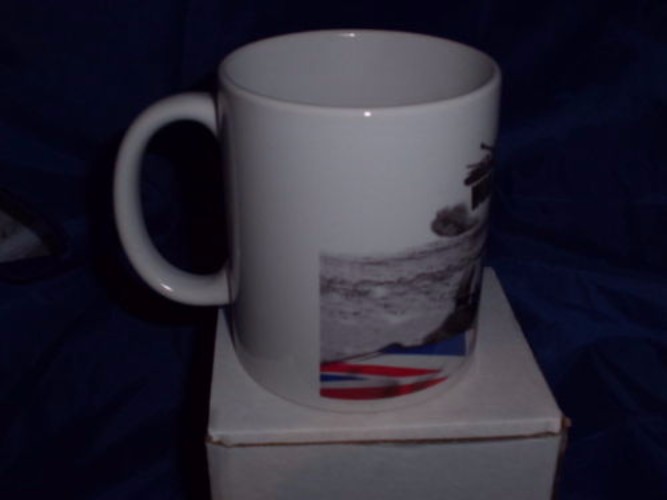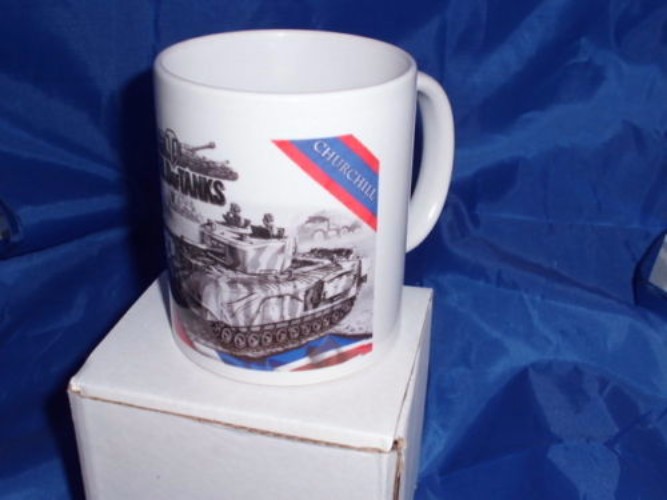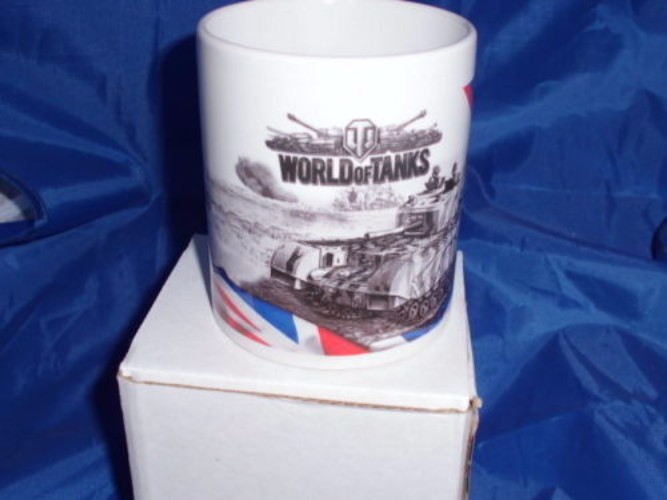World of tanks Churchill tank military mug
11oz World of tanks Churchill tank mug
The Churchill I is a British tier 5 heavy tank.
The A22 prototype was built by Vauxhall Motors in the fall of 1940. The vehicle first entered mass production in the summer of 1941. Early modifications had no track fenders, a different fan, and a 3-inch howitzer in the hull. A total of 300 Churchill I tanks were manufactured.
The Churchill I is by far the slowest heavy tank at Tier 5. It is a very inflexible vehicle with some very glaring weaknesses, but it does have few good traits such as high armour and an accurate gun with good penetration.
The Churchill I leads to the Churchill VII, and the Churchill Gun Carrier.
The Churchill VII is a British tier 6 heavy tank.
A modification of the A22 with enhanced armor. First vehicles of this type were produced just before the Allied landing in Normandy. This model was also the basis for the Churchill Crocodile flame-throwing tank.
The Churchill VII leads to the Black Prince.
Performance
The weakest link in the british heavy tank tree, the Churchill VII is possibly the most difficult Tier 6 heavy tank to use efficiently. The abysmal (lack of) mobility is a real bridle for the tank's performance.
The top 77 mm gun is a slight improvement over the Churchill I's 75 mm Vickers HV gun, but the opposition that the Churchill VII faces is far tougher. The main problem is that anything above the 75 mm gun Mk. V will lower the elevation to meagre 12° while the gun-depression takes a plunge to only 4°, which completely rules out any notions of going hull down on slopes, and makes fighting on uneven terrain exceedingly frustrating. If allowed to fire continuously, the Churchill can rack up damage fairly quickly with its high rate-of-fire, but the Churchill VII simply does not have the speed to chase down targets and keep them under fire. With only 148 mm of penetration, it is barely adequate for Tier 6 and 7 games, and hopelessly outclassed at Tier 8 unless the fairly potent but expensive APCR round is used. However, the gun is rather accurate and the gun-handling (dispersion, aim-time etc) is second to none in the tier.
The Churchill VII does have rid itself of the strange weak-spots in the Churchill I's armour and have great armour at Tier 6, with 152 mm in front armour and good side armour. Notably, the roof of the upgraded turret now is not only exposed from the front, but actually so thin its steep angle gets over-powered for automatic penetration. It can safely ignore most guns with less than 150 mm of penetration, unless the enemy makes the not uncommon decision to simply load premium ammunition and cut through the frontal armour anyway. This armour will also not reliably protect against very powerful guns with more than 160 penetration (which are not so rare at Tier 6), even with angling. It goes without saying that most Tier 7 and 8 tanks will cut through it but with problems. Churchill has a gun that depends on its fast rate-of-fire to rack up damage, it is not very viable to angle the completely flat turret armour between shots. This creates a lot of problems as the lack of a gun mantlet means that most tanks can penetrate the unangled turret front
The mobility of the Churchill, equivalent of the O-I, is its single greatest weakness. With a top speed of only 20 km/h, once committed to a flank, the Churchill is probably going to stay there for the rest of the game. Flanking is exceedingly difficult against all but the most unaware of enemies. It is also not uncommon for teams to collapse before the Churchill gets into position, and there is nothing much that can be done; the curse of all slow tanks. Unsurprisingly, the Churchill turns like a boat, and is easily outflanked. This is partly compensated for with the fast turret traverse, but generally, the Churchill should operate with support covering its flanks and Clutch Braking is an essential skill for the driver.[1]
Overall, in unskilled hands the tank is nothing but a burden to its team and should not be played.
Early Research
The 75 mm Vickers HV Gun, Bedford Twin-Six Engine, and WS No. 19 Mk. III Radio should already be researched from the Churchill I, and should be mounted immediately.
With these modules mounted, you have two choices: If you don't mind being even slower but tougher, research the upgraded turret and mount the stock engine. Else, research the Churchill VII suspension first.
Finally research the OQF 77 mm Gun Mk. II Gun.
Special versions
Presented in chronological order. Many were derived from earlier series, never upgraded to the Mk. VII standard. These were popularly known by the common soldiers as “Hobart’s funnies”.
Churchill Oke
In mid-1942, prior to the upcoming raid on Dieppe, Major J.M. Oke devised a flame-throwing modification, applied to three prototype vehicles, named “Boar”, “Beetle” and “Bull”. A pipe apparatus, with the tank fitted at the rear, was linked to the front left hull Ronson flame projector, leaving the right-hand hull machine-gun unobstructed. The three vehicles were part of the first wave at Dieppe.
Churchill AVRE
The most common modification of all genie versions, designed after the painful raid of Dieppe. This was the typical armored vehicle of the Royal Engineers, equipped with the Petard, a 290 mm (11.41 in) Spigot mortar, which fired an 18 kg (40 lb) warhead and had a practical range of 137 m (150 yards). Its purpose was to clear concrete bunkers and all kind of enemy fortifications and obstacles. Reloading was performed by the co-driver, staying in his hatch, and the turret facing him. It was a basis which could serve for many other purposes, like the mine-flail version, explosive carrier, fascine carrier, brideglayer, etc.
Bobbin carrier
This version was used during landings, on sandy beaches and soft grounds (extremely muddy) in general. A 10 feet large (3 m) canvas bobbin was carried at the front of the leading Churchill, released to create a rolling path for the following vehicles.
Fascine carrier
A WW1 solution was to carry a very large bundle of wooden poles or brushwood at the front of the vehicle, released in trenches and ditches, in order to make a step, allowing other tanks to cross it. When released in a fast-flowing riverbed, metallic hollow tubes were wrapped inside the fascine, to allow water to flow through and avoid having the whole device flushed away.
Small Box Girder
This was an assault bridge carrier. The bridge itself was relatively small (30 feet/9 m), but could be deployed quickly to allow troops and light vehicles to span large gaps or climb impassable obstacles.
Bullshorn Plough
A “minesweeper” Churchill equipped with a large mine plough, tailored to excavate and expose land mines. A mine-flail version, the Toad, was also built after the war, in 1950.
Double Onion
The Double Onion was the successor of the single carrot explosive device. It consisted of two large explosive charges placed on a metal frame, that was laid on a concrete wall and exploded from a safe distance. Another variant was the Churchill Goat.
Churchill ARV
The “Armored Recovery Vehicle” was based on a turretless Mk.I. The front jib had a 7.5 ton capacity and had a counterweight at the rear. The rear jib had 15 ton traction, while the winch could pull 25 tons. The small tailored turret had a dummy gun. A single Besa machine gun served for close quarter defense, and there was enough room inside to carry the damaged tank’s crew.
Churchill ARK
For “Armoured Ramp Carrier”, this turretless vehicle carried a folding bridge. When unfolded, it spanned 65 ft (20 m). The sub-Marks 1 and 2 had trackways either on the tracks or directly on the vehicle itself. In 1945, ten Churchill Great Easterns were delivered. These were conceived by officer engineer and inventor Cecil Vandepeer Clarke. The folded bridge spanned 60 feet and was deployed in seconds using rockets. It seems they never saw action.
Churchill Crocodile
One of the most famous versions of the Churchill, around 800 were built. It was the main Allied flamethrower tank (in Europe), generally a Mark VII with a flamethrower replacing the hull Besa machine gun. The fuel tank was carried in a trailer. The range was 150 yards (137 m), firing one-second bursts.
Churchill Kangaroo
A turretless variant used as an armored personnel carrier (APC). These were the roomier and best-protected versions of the Kangaroo.
Gun Carrier, 3in, Mk I, Churchill (A22D)
This was probably the only attempt to build a tank-hunter based on the Churchill. It was modified to house an anti-aircraft 3 in (76.2mm) Mk.I gun, in a ballmount inside a 3.5 in (88 mm) thick superstructure. Fifty were built in 1942, but their fate remains uncertain. Large scale conversions were dropped, due to the adoption of the 17 pounder.
Churchill Black Prince (A43)
By 1943, the Churchill was the most heavily armored tank in British service, and it was seen as an adequate response to the German Tiger and Panther if rearmed with a more potent weapon, the 17 pounder. It was designed in 1944 on the basis of the Mk.VII at Vauxhall Motors, and adopted the turret developed for the Comet. But weighing ten tons more and having the same old engine, its performances were mediocre at best. By early 1945, only six prototypes had been built and, at the same time, scores of Sherman Fireflies were already available and battle-proven, the last versions of the Cromwell and Centaur were in service, as well as the Challenger and the brand new Comet. Plus, there was already a perfect match for the original 1943 specification of a “universal tank” in development then, the promising and heavily protected Centurion. Consequently, the Black Prince project was seen as redundant and abandoned after only six prototypes.
Churchill Toad
The last use of the Churchill in military service. This heavy mine-clearing flail tank entered service, under the designation FV3902, in 1956 and was a descendant of the famous “Hobart’s Funnies”. 42 of the vehicles were produced, they derved with the Royal Engineers but were never used in a combat environment.
Active service
When the A20 was first planned, the general staff wanted a trench warfare tank. The specifications evolved by the summer of 1940, giving birth to the A22. It was more powerful, and ease-of-manufacture simplifications were applied in order to reduce the time until it could enter production, which became paramount. Simply put, when the very first copies rolled off the line in July 1941, the Churchill had been rushed without proper trials and corrections. These would take place later and gradually, which hampered this tank early on, earning it an ill-deserved reputation, strengthened at Dieppe one year later.
North Africa
The most pressing problem, even more pressing after the first Mk.I/IIs arrived in North Africa, was the unreliability of the Meadows engine. Plus, it had been conceived for a mild climate and suffered heavily under the blistering sun of Libya. Ventilation was all-time poor and access limited, preventing efficient monitoring and maintenance. Despite being fitted with a 75 mm (2.95 in) howitzer, aiming the tank proved more difficult than expected and, by early 1942, the Germans introduced up-armored versions of their main battle tank, the Panzer III, fitted with a 50 mm (1.96 in) gun. The 2-pounder, shared with nearly all other British tanks of the time, was found lacking. Their presence was not felt before the second battle of El Alamein, when the first up-gunned and upgraded Mk.IIIs were first committed in action. The “King’s force”, comprising six Mk.IIIs, decisively supported the 7th Motor Brigade, destroying many German antitank gun positions. None was heavily damaged, and one was found with no less than 80 non-penetrating impacts. This success made the War Office send more, creating three armored regiments and a full brigade, that arrived in February 1943. All older version were withdrawn and shipped back to Great Britain for an overhaul.
The Dieppe Raid
Planned long before August 1942, Operation Rutter was to involve 6000 Canadians and several companies of Commandos. The force was meant to test German defenses and learn about landing operations. 60 Churchills of several types took part in the landings, including three flame-thrower versions, a Bobbin version, demolition and bridging vehicles. The operation proved a failure for a number of reasons.
It is a common myth that the Churchill tanks were stuck on the beach and could not cope with the shingle beach. Most of the Churchill tanks did get off the beach but could not get past some of the concrete tank traps. The few that could not get off the beach had their tracks clogged or broken by the pebbles. The reason most of the Churchill tanks ended up on the beach at the end of the raid is because they were called back to be taken off. Because of enemy fire, the landing craft could not get near the beach to take them off. The Churchill tanks that were knocked out were hit on their track and suspension system. They could not move so were abandoned by their crew. The German 3.7 cm (1.46 in), 5 cm (1.97 in) Pak and French 7.5 cm (2.95 in) guns had difficulty penetrating the Churchill tank’s armor. Only one tank had its armor penetrated.
Tunisia
When the Churchill began to arrive en masse in North Africa, the second battle of El Alamein had been won, and German forces were on the run west, to Tunisia. At the same time, the US and British forces landed in French Algeria and Morocco (Operation Torch), creating a giant pincer movement for the retreating Afrika Korps and what remained of the Italian divisions. Meanwhile, Marshal Kesselring was sent to Tunisia with massive reinforcements, including the German brand new beast, the Tiger. The Churchill III and IV, equipped with 6-pdr guns, were no match for it, but proved their tremendous protection and superior crossing abilities on many actions. Tunisia has a mountainous terrain, and over it, the Churchill motricity was second to none. It could climb up slopes which were deemed impassable for a tank, and so was able to provide infantry support where it was needed, often in areas unexpected by the enemy. On one occasion, a Churchill scored a lucky hit in the turret ring of a Tiger tank, jamming the turret. The crew hastily deserted it, leaving the Tiger as a prize. It was invaluable to British intelligence and now stands at the Bovington museum.
Italy
With its reputation firmly re-established, the Churchill was massively involved during the whole Italian campaign. The main reason was the terrain, favoring infantry, which in turn needed a sturdy support tank, able to deal with the difficult terrain. The Churchill was first in line for this task. The specialized versions of the armored engineers were vital to the entire VIIIth Army and many other Allied forces operating in Italy. The experience gained here also paved the way for better versions, which were massively engaged in Normandy. Most of the modified NA75s saw action there. Their range and efficiency were better than those of a standard Sherman, due to the fact that the Churchill was a sturdier and more stable platform.
Western Europe
Although the Allies massively employed Shermans, the Churchill was always a welcome sight. Many specialized versions took part in the landings on the Normandy beaches, with mine-flail and Bullshorn plough versions, Bobbin versions, even salvage models. The Churchill, with its large tracks and many small boggies, proved invaluable in this sandy terrain. The heavy mortars of most of the AVREs (“petard”) dealt with any fortifications of the Atlantic Wall which had been missed by the planes. The excellent motricity of the Churchill was proven once more during Operation Bluecoat (30-31 July 1944), while capturing a key position, Hill 309. They also saw heavy fighting in the Low Countries.
On the Rhine border, equally fortified, the Churchill again proved highly efficient, especially with the arrival of the Mark VII, impervious to most German AT guns, or when combining a heavy mortar and flame-thrower versions. The “Crocodile” became infamously known for its macabre efficiency, so much so that in some cases, the simple view of one rolling towards a blockhouse triggered a prompt surrender. The Crocodile’s crews also knew too well that, in case they were captured, they could expect no mercy from the enemy. Churchills of all versions were massively engaged during Operation Veritable (the invasion of the Reichland).
Russia & Eastern Europe
The Churchill was also delivered to the USSR via Lend-Lease, a total of 301 Mk. III/IVs were shipped via Murmansk (43 lost en route). Their most memorable action occurred at Kursk, when the 5th Guards Tank Brigade successfully counter-attacked at Prokhorovka. The Russians appreciated the good mobility and large tracks of the vehicle, and excellent protection, comparable to the KV-1.
The Pacific
Less well-known, a few Churchills were also sent to the Australian forces operating in New Guinea, at the end of the war. By mid-1944, it was tested alongside the Sherman, with the Matilda already in service as a reference. The Australians eventually chose the Churchill, which was found very efficient for jungle warfare. However, only 46 of the 510 ordered ever reached the ANZACS, as the order was canceled at the end of the war.
Postwar
The last engagement of the Churchill came in Korea. In 1950, a Crocodile squadron took part in the third Battle of Seoul. Later on, four Churchills decisively supported the defense led by the 1st Battalion, Royal Northumberland Fusiliers, helping to maintain the Allied position there. The regular Churchill was retired from service in 1952, while special versions, like the bridgelayer, were still on active duty in 1970. Many survived and are on display in various museums and collections, some in running condition.
6pdr Main Gun penetration figures
Official British War Department test figures show that the 6pdr Mk.III anti-tank gun firing armor piercing AP rounds would penetrate the following thickness of homogeneous armour plate and these distances: 500 yrds. (457 m) = 79.5 mm; 1000 yrds (914.4 m) = 66.5 mm and 1500 yrds (1371.6 M) = 55 mm. When firing armor-piercing capped (APC) rounds at face-hardened armor plate these are the test results: 500 yrds. (457 m) = 87.5 mm; 1000 yrds (914.4 m) = 72 mm and 1500 yrds (1371.6 M) = 57.4 mm. When firing armour piercing capped ballistic capped (APCBC) rounds at face-hardened armor plate these are the test results: 500 yrds. (457 m) = 89.6 mm; 1000 yrds (914.4 m) = 79.6 mm and 1500 yrds (1371.6 M) = 70.7 mm. When fired at slopped armour it was estimated there would have been 80% success at 30 degrees’ angle of attack.
Official British War Department test figures show that the 6pdr Mk.V anti-tank gun firing armor piercing AP rounds would penetrate the following thickness of homogeneous armour plate and these distances: 500 yrds. (457 m) = 85.5 mm; 1000 yrds (914.4 m) = 72.5 mm and 1500 yrds (1371.6 M) = 60.4 mm. When firing armor-piercing capped (APC) rounds at face-hardened armor plate these are the test results: 500 yrds. (457 m) = 93.8 mm; 1000 yrds (914.4 m) = 76.3 mm and 1500 yrds (1371.6 M) = 61.25 mm. When firing armour piercing capped ballistic capped (APCBC) rounds at face-hardened armor plate these are the test results: 500 yrds. (457 m) = 95.9 mm; 1000 yrds (914.4 m) = 86 mm and 1500 yrds (1371.6 M) = 76.7 mm. When fired at slopped armour it was estimated there would have been 80% success at 30 degrees’ angle of attack.
A22F Churchill Mark VII specifications
Dimensions
24ft 5in x 10ft 8in x 8ft 2in (7.44 x 3.25 x 2.49 m)
Total weight, battle ready
40 tonnes
Crew
5 (commander, driver, co-driver/hull gunner, gunner, loader/radio)
Propulsion
Bedford twin-six petrol, 350 hp (261 kW) at 2,200 rpm
Transmission
Merritt-Brown 4 speed constant mesh epicyclic gearbox
Suspension
22 vertical coil spring bogies
Top speed
15 mph (24 km/h)
Range (road)
56 mi (90 km)
Armament
Vickers QF 75 (75 mm/2.95 in)
2x 0.303 (7.7 mm) Besa machine-guns
Armor
From 25 to 152 mm (0.98-5.98 in)
Total production (Mk.VII-VIII combined)
1600
Churchill NA-75
Around 200 Churchill Mk.IVs were upgraded, prior to “Operation Whitehot”, with 75 mm (2.95 in) guns and mantlets of discarded or destroyed Shermans, in March-June 1944. The conversion was first realized on 48 Mk.IVs in North Africa (hence the “NA”) by Capt. Percy Morrell. The captain had noticed that in the sun of the African desert, the standard recessed mantlet of a Churchill cast a deep shadow, making a clear aiming point for german gunners. Percy was later rewarded for his initiative. To mount the gun, the front turret section had to be cut off and the gun introduced, followed by mantlet slot, and then the whole package was welded over. However, it was a left-hand loading system (the usual British system called for a right-hand loading), and the gun had to be turned upside down and all controls adapted. The turret also had to be counter-balanced, as the gun was heavier.
Operation Bertram
Another way of hiding your tank was to change its shape. This type of deception tactic had been used by the Royal Navy in WW1. They changed the outline of destroyers to look more like merchant ships. When the WW1 German U-boat surfaced to attack the ship with its main gun the screens would drop to enable a full broadside of high explosive shells to be fired at the submarine. These type of ships were called ‘Q’ boats.
During Operation Bertram in the months leading up to the second Battle of El Alamein in North Africa in September – October 1942 camouflage and dummy vehicles were used to deceive the Germans where the next attack was going to come from. Real tanks were disguised as trucks, using light “Sunshield” canopies. To achieve the deception, trucks were parked openly in the tank assembly area for some weeks. Real tanks were similarly parked openly, far behind the front. Two nights before the attack, the tanks replaced the trucks, being covered with “Sunshields” before dawn.
The tanks were replaced that same night with dummies in their original positions, so the armour remained seemingly two or more days’ journey behind the front line. Interviews with captured German senior officers showed that this type of deception was successful: they believed the attack was going to come from the south where they had seen the dummy tanks and vehicles and not in the north. The idea for the Sunshield came from Commander-in-Chief Middle East, General Wavell.
The first heavy wooden prototype was made in 1941 by Jasper Maskelyne, who gave it the name Sunshield. 12 men were needed to lift it. The Mark 2 Sunshield was made of canvas stretched over a light steel tube frame. On 11th November 1942, Prime Minister Winston Churchill announced victory at El Alamein in the House of Common.
During his speech he praised the success of Operation Bertram, “By a marvellous system of camouflage, complete tactical surprise was achieved in the desert. The 10th Corps, which he had seen from the air exercising fifty miles in the rear, moved silently away in the night, but leaving an exact simulacrum of its tanks where it had been, and proceeded to its points of attack.” (Winston Churchill, 1942)

